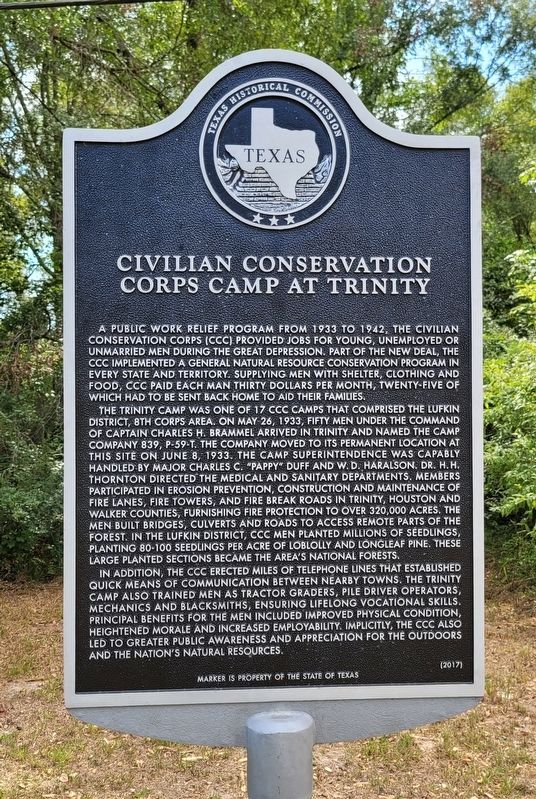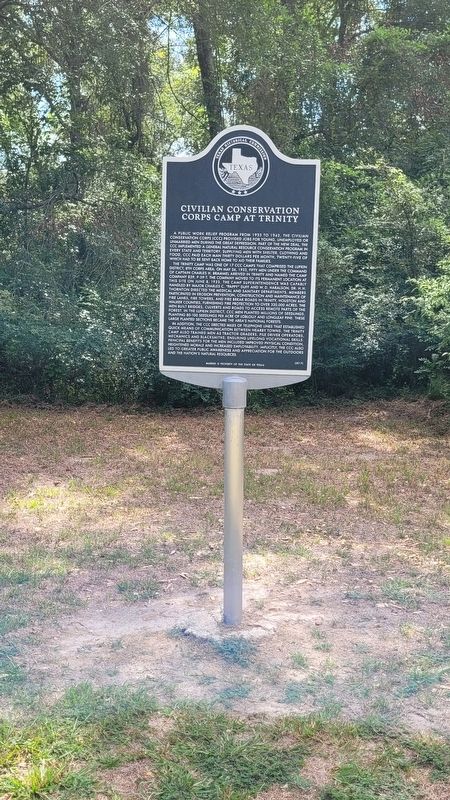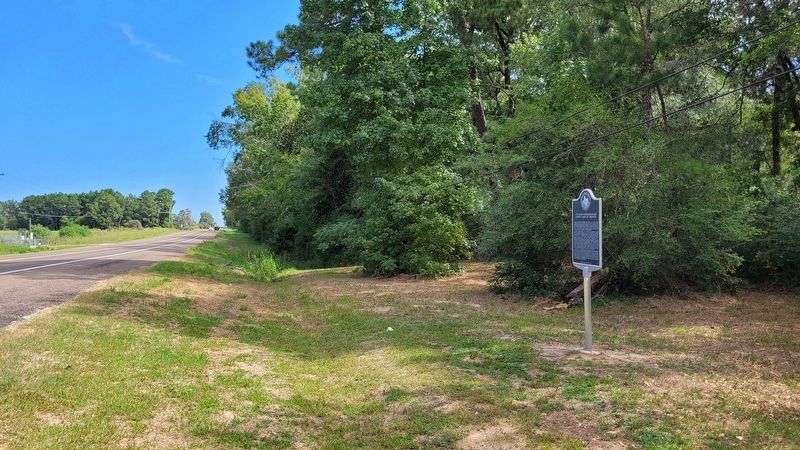Trinity in Trinity County, Texas — The American South (West South Central)
Civilian Conservation Corps Camp at Trinity
Inscription.
A public work relief program from 1933 to 1942, the Civilian Conservation Corps (CCC) provided jobs for young, unemployed or unmarried men during the Great Depression. Part of the New Deal, the CCC implemented a general natural resource conservation program in every state and territory. Supplying men with shelter, clothing and food, CCC paid each man thirty dollars per month, twenty-five of which had to be sent back home to aid their families.
The Trinity Camp was one of 17 CCC camps that comprised the Lufkin District, 8th Corps area. On May 26, 1933, fifty men under the command of Captain Charles H. Brammel arrived in Trinity and named the Camp Company 839, P-59-T. The company moved to its permanent location at this site on June 8, 1933. The camp superintendence was capably handled by Major Charles C. "Pappy" Duff and W.D. Haralson. Dr. H.H. Thornton directed the medical and sanitary departments. Members participated in erosion prevention, construction and maintenance of fire lanes, fire towers, and fire break roads in Trinity, Houston and Walker counties, furnishing fire protection to over 320,000 acres. The men built bridges, culverts and roads to access remote parts of the forest. In the Lufkin District, CCC men planted millions of seedlings, planting 80-100 seedlings per acre of Loblolly and Longleaf Pine. These large planted sections became the area's national forests.
In addition, the CCC erected miles of telephone lines that established quick means of communication between nearby towns. The Trinity Camp also trained men as tractor graders, pile driver operators, mechanics and blacksmiths, ensuring lifelong vocational skills. Principal benefits for the men included improved physical condition, heightened morale and increased employability. Implicitly, the CCC also led to greater public awareness and appreciation for the outdoors and the nation's natural resources.
Erected 2017 by Texas Historical Commission. (Marker Number 18784.)
Topics. This historical marker is listed in these topic lists: Charity & Public Work • Environment • Parks & Recreational Areas • Roads & Vehicles. A significant historical date for this entry is May 26, 1933.
Location. 30° 57.213′ N, 95° 21.348′ W. Marker is in Trinity, Texas, in Trinity County. Marker is on East Caroline Street (State Highway 94) 1.3 miles east of North Robb Street (State Highway 19). The marker is located at a small auto pullout on the south side of State Highway 94. Touch for map. Marker is at or near this postal address: 375 East Caroline Street, Trinity TX 75862, United States of America. Touch for directions.
Other nearby markers. At least 8 other markers are within 2 miles of this marker, measured as the crow flies. Site of Gibson Hotel (approx. 1.2 miles away); Dorcas Wills Memorial Baptist Church
(approx. 1.2 miles away); Charles Nesbitt "Charlie" Wilson (approx. 1.3 miles away); First United Methodist Church of Trinity (approx. 1.3 miles away); I.N. Parker House (approx. 1.4 miles away); Old Red Schoolhouse (approx. 1.4 miles away); Waco, Beaumont, Trinity & Sabine Railroad (approx. 1.4 miles away); Ranald McDonald House (approx. 1˝ miles away). Touch for a list and map of all markers in Trinity.
Also see . . . Civilian Conservation Corps. Texas State Historical Association
The Civilian Conservation Corps, proposed by President Franklin Roosevelt, operated nationwide between 1933 and 1942. it provided outdoor employment for 2.5 million young men working out of nearly 3,000 camps. The camps of 200 men each were supervised by the United States Army and the work projects by the departments of Agriculture and Interior, in cooperation with the state. At individual camps the CCC hired LEMs ("locally experienced men") to work as craftsmen and teachers, and professional architects and engineers to provide design assistance and construction supervision to enrollees. To be an enrollee, a young man was required to be seventeen to twenty-five years of age and from a family on relief. The pay was thirty dollars a month, of which twenty-five dollars was sent directly to the family. Veterans of World War I were also eligible and were housed in separate camps.(Submitted on September 30, 2022, by James Hulse of Medina, Texas.)
Credits. This page was last revised on September 30, 2022. It was originally submitted on September 29, 2022, by James Hulse of Medina, Texas. This page has been viewed 182 times since then and 35 times this year. Photos: 1, 2, 3. submitted on September 30, 2022, by James Hulse of Medina, Texas.


